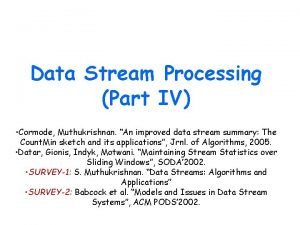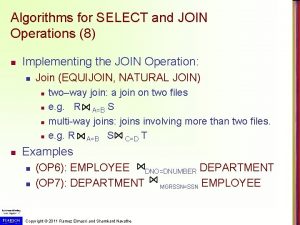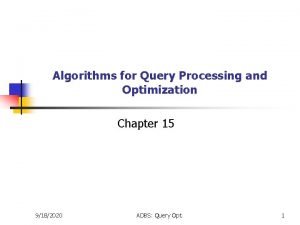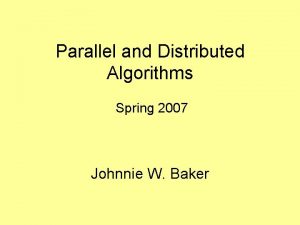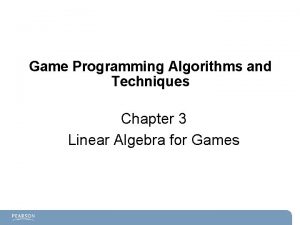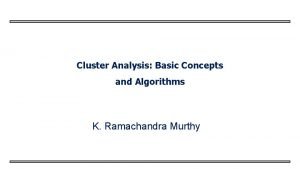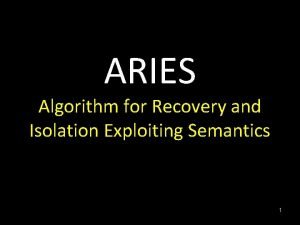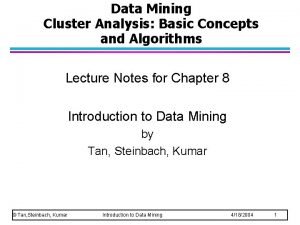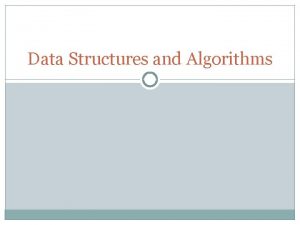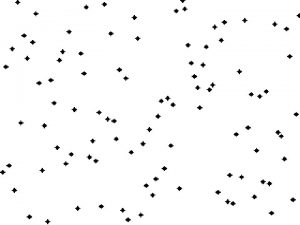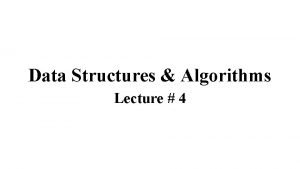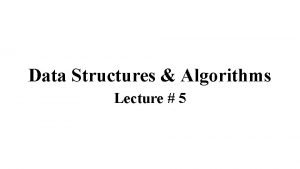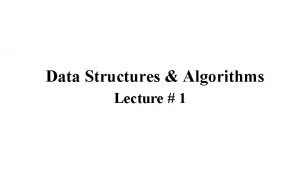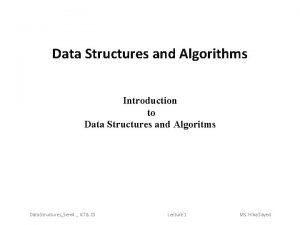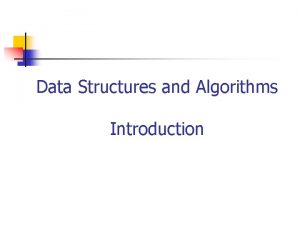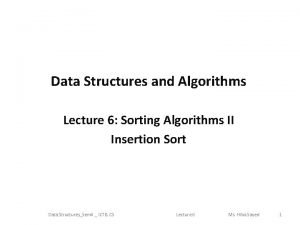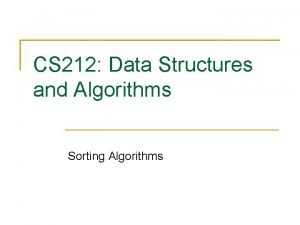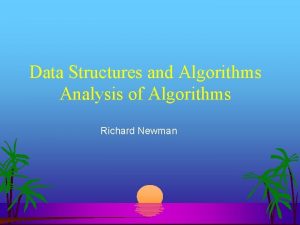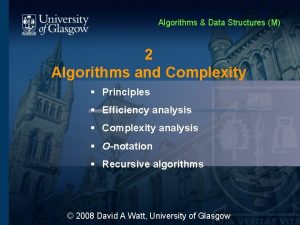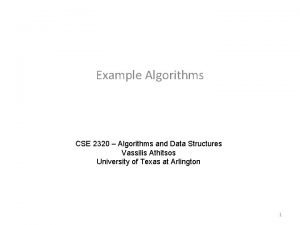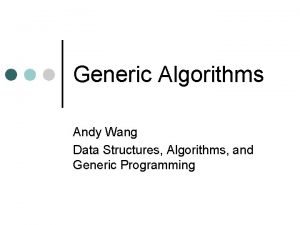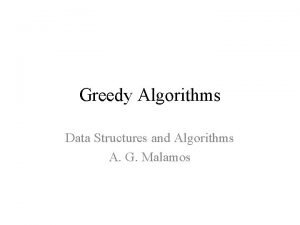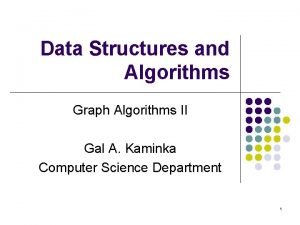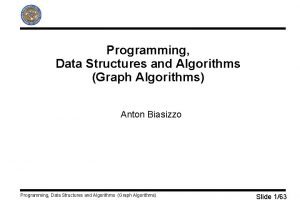Data Structures and Algorithms and Data Structures Data

































- Slides: 33

Data Structures and Algorithms and Data Structures ﺳﺎﺧﺘﻤﺎﻥ ﺩﺍﺩﻩﻫﺎ ﻭ

Data Structures and Algorithms Outline 2. 2 This topic will describe: – The concrete data structures that can be used to store information – The basic forms of memory allocation • Contiguous • Linked • Indexed – The prototypical examples of these: arrays and linked lists – Other data structures: • Trees • Hybrids • Higher-dimensional arrays – Finally, we will discuss the run-time of queries and operations on arrays and linked lists 2

Data Structures and Algorithms Memory Allocation 2. 2. 1 Memory allocation can be classified as either – Contiguous – Linked – Indexed Prototypical examples: – Contiguous allocation: – Linked allocation: arrays linked lists 3

Data Structures and Algorithms 4 Memory Allocation 2. 2. 1. 1 Contiguous, adj. Touching or connected throughout in an unbroken sequence. Meriam Webster Touching, in actual contact, next in space; meeting at a common boundary, bordering, adjoining. www. oed. com

Data Structures and Algorithms 2. 2. 1. 1 2. 2. 1 Contiguous Allocation An array stores n objects in a single contiguous space of memory Unfortunately, if more memory is required, a request for new memory usually requires copying all information into the new memory – In general, you cannot request for the operating system to allocate to you the next n memory locations 5

Data Structures and Algorithms 2. 2. 1. 2 Linked Allocation Linked storage such as a linked list associates two pieces of data with each item being stored: – The object itself, and – A reference to the next item • In C++ that reference is the address of the next node 6

Data Structures and Algorithms 2. 2. 1. 2 Linked Allocation 7 This is a class describing such a node template <typename Type> class Node { /* Linked list Node*/ private: class Node { Type node_value; int data; Node *next_node; Node next; public: // Constructor to create a new node //. . . // Next is by default initialized as null }; Node(int d) { data = d; } }

Data Structures and Algorithms 2. 2. 1. 2 8 Linked Allocation The operations on this node must include: – Constructing a new node – Accessing (retrieving) the value – Accessing the next pointer Node first = new Node(1); Node second = new Node(2); Node third = new Node(3); Node( const Type& = Type(), Node* = nullptr ); Type value() const; first. data = 100; Node *next() const; first. next = second; second. next = first; Pointing to nothing has been represented as: C NULL Java/C# null C++ (old) 0 100 C++ (new) nullptr Symbolically Ø 2 3 null

Data Structures and Algorithms 2. 2. 1. 2 Linked Allocation For a linked list, however, we also require an object which links to the first object The actual linked list class must store two pointers – A head and tail: Node *head; Node *tail; Optionally, we can also keep a count int count; The next_node of the last node is assigned nullptr 9

Data Structures and Algorithms 2. 2. 1. 2 Linked Allocation The class structure would be: class Linked. List { Node head; // head of list Node tail; int count; template <typename Type> class List { private: public void Linked. List() { … } Node<Type> *head; public void add(int n) { … } Node<Type> *tail; … int count; } public: // constructor(s). . . // accessor(s). . . // mutator(s). . . }; Linked. List L = new Linked. List(); L. head = first; L. tail = third; 10

Data Structures and Algorithms 2. 2. 1. 3 Indexed Allocation With indexed allocation, an array of pointers (possibly NULL) link to a sequence of allocated memory locations Used in the C++ standard template library Computer engineering students will see indexed allocation in their operating systems course 11

Data Structures and Algorithms 2. 2. 1. 3 Indexed Allocation Matrices can be implemented using indexed allocation: 12

Data Structures and Algorithms 2. 2. 1. 3 Indexed Allocation Matrices can be implemented using indexed allocation – Most implementations of matrices (or higher-dimensional arrays) use indices pointing into a single contiguous block of memory Row-major order Column-major order C, Python Matlab, Fortran 13

Data Structures and Algorithms Other Allocation Formats 2. 2. 2 We will look at some variations or hybrids of these memory allocations including: – – Trees Graphs Deques (linked arrays) inodes 14

Data Structures and Algorithms 2. 2 Trees The linked list can be used to store linearly ordered data – What if we have multiple next pointers? A rooted tree (weeks 4 -6) is similar to a linked list but with multiple next pointers 15

Data Structures and Algorithms Trees 2. 2 A tree is a variation on a linked list: – – Each node points to an arbitrary number of subsequent nodes Useful for storing hierarchical data We will see that it is also useful for storing sorted data Usually we will restrict ourselves to trees where each node points to at most two other nodes 16

Data Structures and Algorithms 2. 2 Graphs Suppose we allow arbitrary relations between any two objects in a container – Given n objects, there are n 2 – n possible relations • If we allow symmetry, this reduces to – For example, consider the network 17

Data Structures and Algorithms 2. 2 18 Arrays Suppose we allow arbitrary relations between any two objects in a container – We could represent this using a two-dimensional array A B C D E F G H – In this case, the matrix is symmetric A × × B × C × × D × × E F × G × L × × × I × × K × H J × × × × I × × K × L × × ×

Data Structures and Algorithms 2. 2 Array of Linked Lists Suppose we allow arbitrary relations between any two objects in a container – Alternatively, we could use a hybrid: an array of linked lists A B C D E F G H I J K L 19

Data Structures and Algorithms 2. 2. 2. 3 Linked Arrays Other hybrids are linked lists of arrays – Something like this is used for the C++ STL deque container For example, the alphabet could be stored either as: – An array of 26 entries, or – A linked list of arrays of 8 entries 20

Data Structures and Algorithms 2. 2. 2. 4 Hybrid data structures The Unix inode was used to store information about large files – The first twelve entries can reference the first twelve blocks (48 Ki. B) 21

Data Structures and Algorithms 2. 2. 2. 4 Hybrid data structures 22 The Unix inode was used to store information about large files – The next entry is a pointer to an array that stores the next 1024 blocks This stores files up to 4 Mi. B on a 32 -bit computer

Data Structures and Algorithms 2. 2. 2. 4 Hybrid data structures The Unix inode was used to store information about large files – The next entry has two levels of indirection for files up to 4 Gi. B 23

Data Structures and Algorithms 2. 2. 2. 4 Hybrid data structures The Unix inode was used to store information about large files – The last entry has three levels of indirection for files up to 4 Ti. B 24

Data Structures and Algorithms 2. 2. 3 Algorithm run times Once we have chosen a data structure to store both the objects and the relationships, we must implement the queries or operations as algorithms – The Abstract Data Type will be implemented as a class – The data structure will be defined by the member variables – The member functions will implement the algorithms The question is, how do we determine the efficiency of the algorithms? 25

Data Structures and Algorithms 26 Operations 2. 2. 3 We will use the following matrix to describe operations at the locations within the structure Front/1 st Arbitrary Location Back/nth Find Insert ? ? Erase ? ? ?

Data Structures and Algorithms 27 Operations on Sorted Lists 2. 2. 3. 1 Given an sorted array, we have the following run times: Front/1 st Arbitrary Location Back/nth Find Insert Good Bad Okay Bad Good* Bad Erase Bad Good * only if the array is not full

Data Structures and Algorithms 28 Operations on Lists 2. 2. 3. 2 vs. linked list If the array is not sorted, only one operations changes: Front/1 st Arbitrary Location Back/nth Find Insert Good Bad Bad Good* Bad Erase Bad Good * only if the array is not full

Data Structures and Algorithms 29 Operations on Lists 2. 2. 3. 3 However, for a singly linked list where we a head and tail pointer, we have: Front/1 st Arbitrary Location Back/nth Find Insert Good Bad Good Erase Good Bad

Data Structures and Algorithms 30 Operations on Lists 2. 2. 3. 4 For a doubly linked list, one operation becomes more efficient: Front/1 st Arbitrary Location Back/nth Find Insert Good Bad Good Erase Good

Data Structures and Algorithms Following Classes The next topic, asymptotic analysis, will provide the mathematics that will allow us to measure the efficiency of algorithms It will also allow us the measure the memory requirements of both the data structure and any additional memory required by the algorithms 31

Data Structures and Algorithms Summary In this topic, we have introduced the concept of data structures – We discussed contiguous, linked, and indexed allocation – We looked at arrays and linked lists – We considered • Trees • Two-dimensional arrays • Hybrid data structures – We considered the run time of the algorithms required to perform various queries and operations on specific data structures: • Arrays and linked lists 32

Data Structures and Algorithms References Wikipedia, https: //en. wikipedia. org/wiki/Data_structure These slides are provided for the ECE 250 Algorithms and Data Structures course. The material in it reflects Douglas W. Harder’s best judgment in light of the information available to him at the time of preparation. Any reliance on these course slides by any party for any other purpose are the responsibility of such parties. Douglas W. Harder accepts no responsibility for damages, if any, suffered by any party as a result of decisions made or actions based on these course slides for any other purpose than that for which it was intended. 33
 Data structures and algorithms iit bombay
Data structures and algorithms iit bombay Kevin wayne princeton
Kevin wayne princeton Data structures and algorithms tutorial
Data structures and algorithms tutorial Information retrieval data structures and algorithms
Information retrieval data structures and algorithms Data structures and algorithms bits pilani
Data structures and algorithms bits pilani Ajit diwan iit bombay
Ajit diwan iit bombay Data structures and algorithms
Data structures and algorithms Data structures and algorithms
Data structures and algorithms Waterloo data structures and algorithms
Waterloo data structures and algorithms Signature file structure in information retrieval system
Signature file structure in information retrieval system Data structures and algorithms
Data structures and algorithms Algorithms + data structures = programs
Algorithms + data structures = programs Biology homology
Biology homology Stream data model
Stream data model Computational thinking algorithms and programming
Computational thinking algorithms and programming 1001 design
1001 design Association analysis: basic concepts and algorithms
Association analysis: basic concepts and algorithms Computer arithmetic: algorithms and hardware designs
Computer arithmetic: algorithms and hardware designs Algorithms for select and join operations
Algorithms for select and join operations Algorithms and flowcharts
Algorithms and flowcharts Undecidable problems and unreasonable time algorithms.
Undecidable problems and unreasonable time algorithms. Cluster analysis basic concepts and algorithms
Cluster analysis basic concepts and algorithms Probabilistic analysis and randomized algorithms
Probabilistic analysis and randomized algorithms Design and analysis of algorithms introduction
Design and analysis of algorithms introduction Algorithms for query processing and optimization
Algorithms for query processing and optimization Synchronization algorithms and concurrent programming
Synchronization algorithms and concurrent programming Parallel and distributed algorithms
Parallel and distributed algorithms Game programming algorithms and techniques
Game programming algorithms and techniques Cluster analysis basic concepts and algorithms
Cluster analysis basic concepts and algorithms Cluster analysis basic concepts and algorithms
Cluster analysis basic concepts and algorithms Aries recovery algorithm
Aries recovery algorithm Digital signal processor architecture
Digital signal processor architecture Parametric and non parametric algorithms
Parametric and non parametric algorithms Exercise 24
Exercise 24













